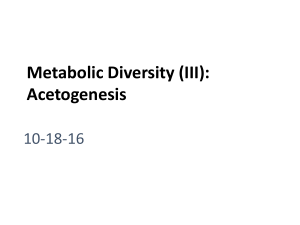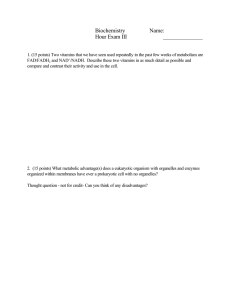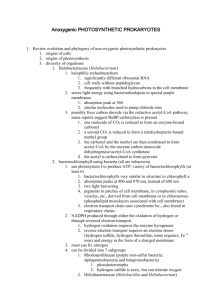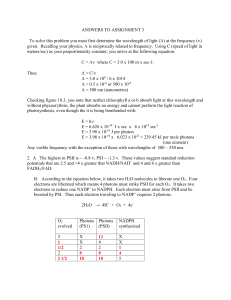Clostridium thermoaceticum By Viewing the Old, We Learn the New
advertisement
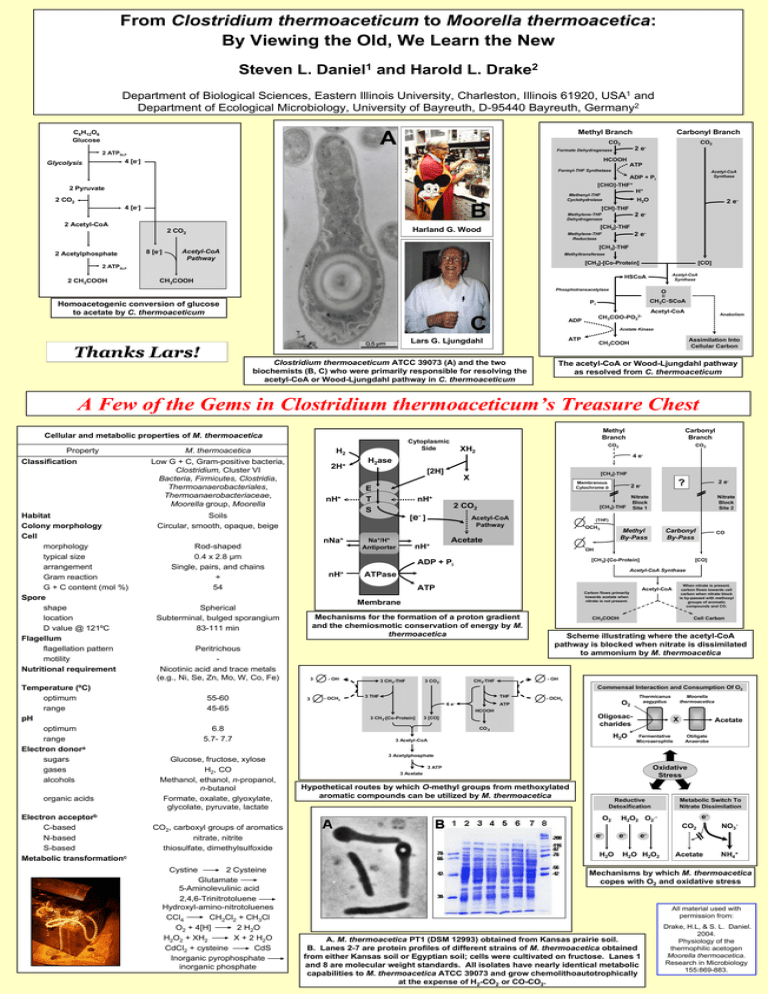
From Clostridium thermoaceticum to Moorella thermoacetica: By Viewing the Old, We Learn the New 1 Daniel Steven L. and Harold L. 2 Drake Department of Biological Sciences, Eastern Illinois University, Charleston, Illinois 61920, USA1 and Department of Ecological Microbiology, University of Bayreuth, D-95440 Bayreuth, Germany2 C6H12O6 Glucose Methyl Branch A CO2 CO2 2 e- Formate Dehydrogenase 2 ATPSLP HCOOH 4 [e-] Glycolysis Carbonyl Branch ATP Formyl-THF Synthetase Acetyl-CoA Synthase ADP + Pi [CHO]-THF+ 2 Pyruvate H+ Methenyl-THF Cyclohydrolase 2 CO2 B 4 [e-] 2 Acetyl-CoA 2 Acetylphosphate 8 [e-] 2 e- Methylene-THF Dehydrogenase [CH2]-THF 2 e- Methylene-THF Reductase [CH3]-THF Acetyl-CoA Pathway Methyltransferase [CH3]-[Co-Protein] 2 ATPSLP 2 CH3COOH 2 e- [CH]-THF Harland G. Wood 2 CO2 H2O [CO] Acetyl-CoA Synthase HSCoA CH3COOH Phosphotransacetylase = O Homoacetogenic conversion of glucose to acetate by C. thermoaceticum Acetyl-CoA C Anabolism CH3COO-PO32- ADP Acetate Kinase ATP Lars G. Ljungdahl Thanks Lars! CH3C-SCoA Pi Clostridium thermoaceticum ATCC 39073 (A) and the two biochemists (B, C) who were primarily responsible for resolving the acetyl-CoA or Wood-Ljungdahl pathway in C. thermoaceticum Assimilation Into Cellular Carbon CH3COOH The acetyl-CoA or Wood-Ljungdahl pathway as resolved from C. thermoaceticum A Few of the Gems in Clostridium thermoaceticum’s Treasure Chest Cellular and metabolic properties of M. thermoacetica Property Classification Habitat Colony morphology Cell morphology typical size arrangement Gram reaction G + C content (mol %) Spore shape location D value @ 121ºC Flagellum flagellation pattern motility Nutritional requirement Temperature (ºC) optimum range pH optimum range Electron donora sugars gases alcohols organic acids Electron acceptorb C-based N-based S-based Metabolic transformationc M. thermoacetica Cytoplasmic Side H2 Low G + C, Gram-positive bacteria, Clostridium, Cluster VI Bacteria, Firmicutes, Clostridia, Thermoanaerobacteriales, Thermoanaerobacteriaceae, Moorella group, Moorella 2H+ Soils Circular, smooth, opaque, beige nNa+ Rod-shaped 0.4 x 2.8 µm Single, pairs, and chains + 54 [2H] [CH2]-THF X Membranous Cytochrome b nH+ T S 2 CO2 [e- ] Na+/H+ Antiporter Acetyl-CoA Pathway nH+ 2 e- OCH3 Nitrate Block Site 2 Methyl By-Pass Carbonyl By-Pass CO OH [CH3]-[Co-Protein] [CO] Acetyl-CoA Synthase ATPase - OH 2 e- (THF) Acetate 3 CH3-THF CH3COOH Cell Carbon Scheme illustrating where the acetyl-CoA pathway is blocked when nitrate is dissimilated to ammonium by M. thermoacetica - OH CH3-THF 3 CO 2 When nitrate is present, carbon flows towards cell carbon when nitrate block is by-passed with methoxyl groups of aromatic compounds and CO. Acetyl-CoA Carbon flows primarily towards acetate when nitrate is not present. Mechanisms for the formation of a proton gradient and the chemiosmotic conservation of energy by M. thermoacetica 3 ? Nitrate Block [CH3]-THF Site 1 Membrane Peritrichous Nicotinic acid and trace metals (e.g., Ni, Se, Zn, Mo, W, Co, Fe) CO2 H2ase ATP Spherical Subterminal, bulged sporangium 83-111 min CO2 4 e- ADP + Pi nH+ Carbonyl Branch XH2 E nH+ Methyl Branch Commensal Interaction and Consumption Of O2 55-60 45-65 3 - OCH3 3 THF THF 6 e- Glucose, fructose, xylose H2, CO Methanol, ethanol, n-propanol, n-butanol Formate, oxalate, glyoxylate, glycolate, pyruvate, lactate O2 ATP 3 [CO] CO 2 H2 O 3 Acetyl-CoA 2 Cysteine Glutamate 5-Aminolevulinic acid 2,4,6-Trinitrotoluene Hydroxyl-amino-nitrotoluenes CCl4 CH2Cl2 + CH3Cl O2 + 4[H] 2 H 2O H2O2 + XH2 X + 2 H2O CdCl2 + cysteine CdS Inorganic pyrophosphate inorganic phosphate X Fermentative Microaerophile Acetate Obligate Anaerobe 3 Acetylphosphate Oxidative Stress 3 ATP 3 Acetate Hypothetical routes by which O-methyl groups from methoxylated aromatic compounds can be utilized by M. thermoacetica Reductive Detoxification eH2 O Cystine Moorella thermoacetica Oligosaccharides O2 CO2, carboxyl groups of aromatics nitrate, nitrite thiosulfate, dimethylsulfoxide Thermicanus aegyptius HCOOH 3 CH 3-[Co-Protein] 6.8 5.7- 7.7 - OCH3 Metabolic Switch To Nitrate Dissimilation e- H2O2 O2.e- CO2 NO3- Acetate NH4+ e- H2O H2O2 Mechanisms by which M. thermoacetica copes with O2 and oxidative stress All material used with permission from: A. M. thermoacetica PT1 (DSM 12993) obtained from Kansas prairie soil. B. Lanes 2-7 are protein profiles of different strains of M. thermoacetica obtained from either Kansas soil or Egyptian soil; cells were cultivated on fructose. Lanes 1 and 8 are molecular weight standards. All isolates have nearly identical metabolic capabilities to M. thermoacetica ATCC 39073 and grow chemolithoautotrophically at the expense of H2-CO2 or CO-CO2. Drake, H.L, & S. L. Daniel. 2004. Physiology of the thermophilic acetogen Moorella thermoacetica. Research in Microbiology 155:869-883.
